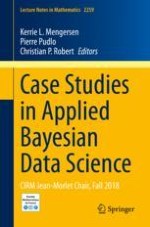Presenting a range of substantive applied problems within Bayesian Statistics along with their Bayesian solutions, this book arises from a research program at CIRM in France in the second semester of 2018, which supported Kerrie Mengersen as a visiting Jean-Morlet Chair and Pierre Pudlo as the local Research Professor.
The field of Bayesian statistics has exploded over the past thirty years and is now an established field of research in mathematical statistics and computer science, a key component of data science, and an underpinning methodology in many domains of science, business and social science. Moreover, while remaining naturally entwined, the three arms of Bayesian statistics, namely modelling, computation and inference, have grown into independent research fields. While the research arms of Bayesian statistics continue to grow in many directions, they are harnessed when attention turns to solving substantive applied problems. Each such problem set has its own challenges and hence draws from the suite of research a bespoke solution.
The book will be useful for both theoretical and applied statisticians, as well as practitioners, to inspect these solutions in the context of the problems, in order to draw further understanding, awareness and inspiration.
